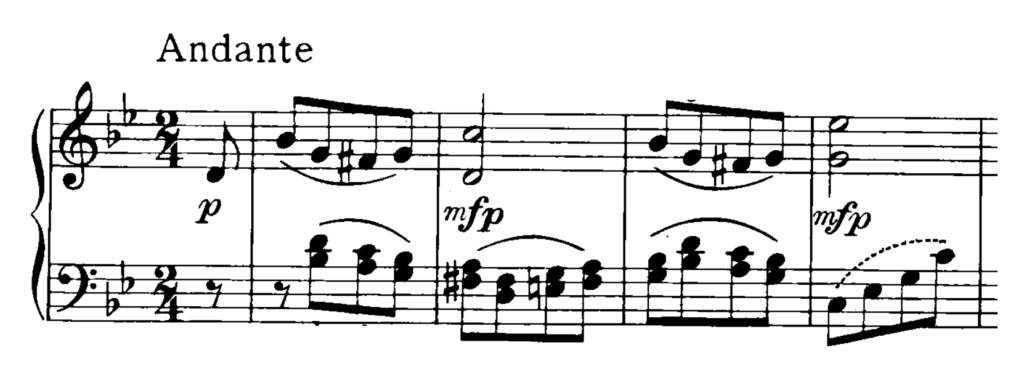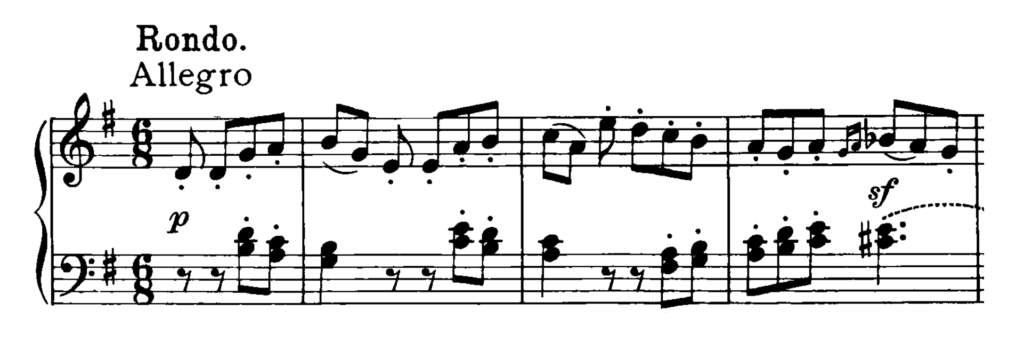Analysis
Contents
For the benefit of all pianists learning this work, we present to you a concise and easy to use analysis of Beethoven’s Piano Sonata No.19 in G minor.
First Movement (Andante)
Form: Sonata Form. G Minor.
EXPOSITION:
Bars 1-9: First Subject in G minor (tonic). The first subject consists of a section of eight bars, ending with half-close upon the dominant.
Bars 9-16: Connecting Episode. The connecting episode begins with the first four bars of the first subject, after which it modulates into the key of F major, dominant of the relative major.
Bars 17-30: Second Subject in B flat major. The second subject being with two-bar phrase, Bars 17-18, repeated, eighth higher, Bars 19-20, and again at Bars 21-22. At Bar 22 this phrase overlaps the commencement of a four-bar phrase, Bars 22-25, repeated (varied and extended), Bars 26-30.
Bars 30-34: Coda. The Coda is taken from the beginning of the second subject.
Double bar and repeat.
DEVELOPMENT:
Bars 33-66: Nearly all of the development is constructed upon fragments of the second subject. Bars 35-50 are in the key of E flat, followed by a (transient) modulation to C minor, and then to tonic key, in which it continues to the end, where it closes upon dominant seventh, the C natural rising to C sharp, and then D. See Sonata No. 10, first movement, Bar 126.
RECAPITULATION:
Bars 66-73: First Subject in original key.
Bars 73-81: Connecting Episode. The connecting episode resembles the original one, altered so as to end in the dominant key instead of the key of F.
Bars 82-99: Second Subject in G minor (tonic). The latter part of the second subject is varied and extended on its re-appearance.
Bars 99-End: Coda. The Coda is formed of the same material as that in the exposition; but it is extended, the last eight bars being upon pedal point. The movement ends with a major triad upon the tonic.
Second Movement (Allegro)
Form: Rondo Form. G Major.
FIRST PART:
Bars 1-17: First Subject in G major (tonic). The first subject consists of an eight-bar sentence, Bars 1-9, followed by a four-bar section, Bars 9-13, after which the second section of the first sentence, Bars 5-9, is repeated, Bars 13-17. It ends with a full close in the tonic key, Bar 17.
Bars 17-31: Episode, beginning in G minor. The episode, after four bars of introduction, Bars 17-20, begins in G minor, with a four-bar phrase ending in D minor, Bars 21-24. The same phrase is the repeated, varied and extended, modulating to the key of B flat major, in which it ends, Bars 25-31.
Bars 31-33: Bars 31-33 form a connecting passage.
Bars 33-65: Second Subject in B flat major. The second subject, instead of being in D major, is in B flat major. The last part of the second subject, Bars 49-57, is repeated, Bars 57-65.
Bars 65-79: Episode. This episode consists of a complete repetition of the previous episode, the last four bars, 76-79, being altered to end in G minor instead of in the key of B flat major.
Bars 79-81: Bars 79-81 form a connecting passage.
Bars 81-97: First Subject in original key. The first subject re-appears in its entirety.
SECOND PART:
Bars 97-104: The development is of short duration; it is founded upon the first subject and is of a sequential nature, modulating into E minor, C major, A minor, and G major, and ending in the dominant key.
THIRD PART:
Bars 104-136: Second Subject in G major (tonic). The third part, instead of beginning with the third entry of the first subject, commences with the repetition of the second subject transposed into the tonic key.
Bars 136-154: First Subject in original key. The first subject is much varied and extended.
Bars 154-End: Coda. The Coda is constructed upon tonic pedal point.








